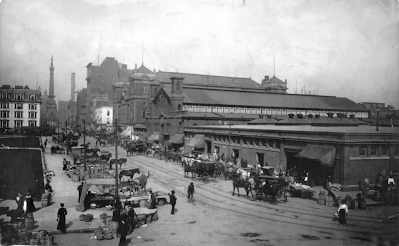Bill makes a good point here. When I first saw the title of Bill Maher's latest video, "Make the Mall Great Again," I was skeptical. I don't always agree with the blowhard who likes to sometimes play both sides of the fence. But after watching the linked video, I have to say, "Yeah, that makes sense."
I began thinking of my birthplace, Princeton, Indiana.
The once thriving agricultural and industrial center of Southwest Indiana boasted a classic courthouse and town square that was at it's zenith in the late 1930's. The Southern Railroad Shops, opened in the mid-1890's, brought more industry to the agricultural town. Across from the shops on the southern edge of town, sat the Heinz factory. Still, agriculture was the economy of that part of the state until the crisis of the 70's and 80's hit farmers and the Midwest hard.
The point is, everyone from surrounding communities used to congregate at the old town square. It was the hub of activity for Gibson County, established in 1814 before Indiana became the 19th state. People from the small hamlet of Francisco, some seven miles away, where my mother was raised, would hitch up the wagon and ride into town. The Princeton square was the place to find the latest fashions, to go for a meal, socialize and hear town gossip.
This idea of a central marketplace dates back to the earliest civilizations. Maher makes this point in his video.
The Princeton square was simply a place around which to "cruise" when I was a kid. Like my parents did in high school, we'd ride downtown, around the square and back out west to the NEW hub of commerce along the highway bypass, U.S. 41. The old hub was in decline, some of it's buildings abandoned and deteriorating.
The move west towards the highway took it's toll on downtown Princeton. Main Street was the old highway. It dated back to pioneer times and the old wagon route from Red Banks (Henderson, Kentucky) to the Territorial Capitol of Vincennes. Princeton was a midpoint. And that old wagon trail that became U.S. 41, ran right past the courthouse, framing the east side of the square. Once the square was bypassed to better facilitate north-south traffic, it began to lose it's centrality to the town and surrounding communities. It was no longer the place to meet and greet.
By the 1990's, people began crying foul that big box stores, like Walmart and Menards, were killing local businesses and downtown traffic. It was the draw to these mini-malls that kept people moving past the courthouse and town square to the commerce centers along U.S. 41 west of there. That was the demise of the downtown shopping district, which is now seeing a revival, of sorts.
All that highlights what Maher is saying about the decentralization and compartmentalization of our society. In the 2000's, it's not just the big box retailers and urban sprawl. Now, it's the online marketplace and the fact that you no longer need to leave your house to shop Walmart or Menards. With a single click, you can have those goods delivered right to your doorstep.
Yes, the malls and big box retailers might have replaced the downtown marketplace, but even that was better (socio-economically AND ecologically) than today's shop-by-phone. We really have isolated ourselves inside our homes by and large. Nowadays, only large festivals and fairs bring people to a common center. Such is the case with Heritage Days at the Princeton Square every year or the Gibson County Fair north of town. People have found less and less reasons to congregate, especially in the heart of town.
Many town squares in rural towns resemble ghost towns these days. They are just the drive-by areas in fly-over states, like Indiana.
And many of those planes flying over are operated by FedEx and UPS, carrying payloads of packages we've ordered online...the stuff we used to get from stores around the square.
That's progress?


No comments:
Post a Comment